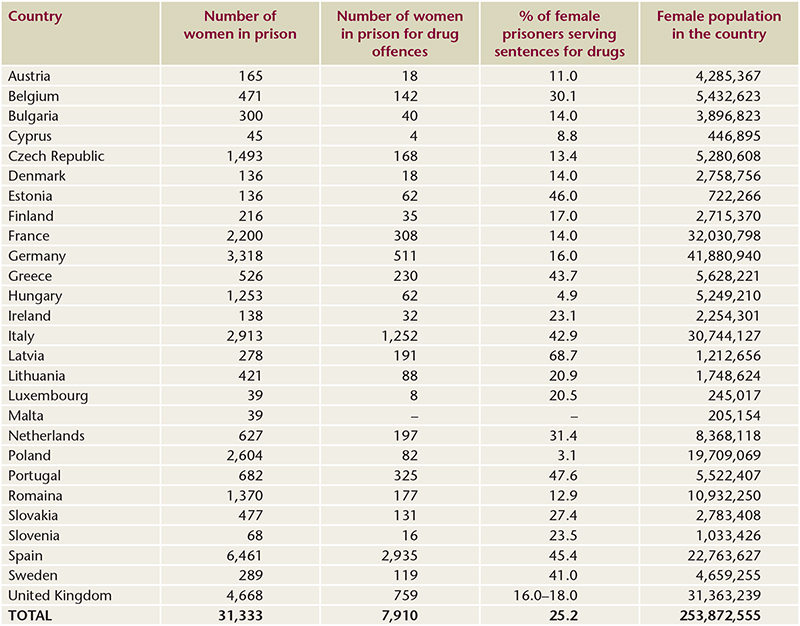Pike, Brigid
(2012)
International Women’s Day and the drugs issue.
Drugnet Ireland,
Issue 42, Summer 2012,
pp. 6-7.
In 1975, International Women's Year, the United Nations nominated 8 March as International Women's Day. It is seen as an annual opportunity to celebrate women's economic, political and social achievements and to renew calls for gender equality and women's empowerment. International drug-related organisations use the day to draw attention to the gender-specific problems that women experience in regard to illicit drugs.
The theme of International Women’s Day 2012 was ‘Empower rural women – end hunger and poverty’. In line with this theme, the UNODC is working with rural women in parts of Asia and Latin America to equip them with knowledge relating to sources of livelihood that are alternatives to the cultivation of illicit crops used in the manufacture of illegal drugs, such as heroin and opium, to address drug abuse and HIV and to protect the environment.
The European Monitoring Centre for Drugs and Drug Addiction marked International Women’s Day 2012 by listing on its home page all its publications that have reported on drug-related gender issues since 1995.
In Europe, up to a quarter of people who have developed serious problems related to the use of illegal drug use are women. Approximately one in four drug users entering drug treatment are female and one in five deaths directly related to drug use are among women.
EMCDDA
· Women's voices (Thematic paper, EMCDDA, 2009)– quotations gleaned from interviews with women in eight countries. Through these testimonies, the report illustrates how qualitative research can provide glimpses into the experiences and perceptions of women facing drug issues that statistics alone cannot provide.
Every year the EMCDDA publishes a
Statistical Bulletin containing the most recent statistical data relating to the drugs situation in Europe. The bulletin includes gender-specific data on treatment demand, drug-related deaths, and drug use among youth and the schools population.
Shortly after International Women’s Day, at its 55th session, between 12 and 16 March, the CND, the policy-setting body of the UN in relation to illicit drugs, adopted a resolution ‘promoting strategies and measures addressing specific needs of women in the context of comprehensive and integrated drug demand reduction programmes and strategies’.
The resolution urges/encourages member states to:
· incorporate female-oriented programmes and integrate essential female-specific services in their drug policies and strategies;
· accommodate the specific needs of drug-dependent parents, including childcare and parental education;
· take into account the needs of women who have experienced sexual and other violent trauma related to drug abuse when designing, implementing and evaluating integrated drug prevention and treatment and HIV prevention programmes;
· take into account the specific needs of women in the prevention, early detection and intervention, treatment and care of drug dependence and drug-related diseases, including infectious diseases and psychiatric disorders, as well as related support services, including for rehabilitation, reintegration and recovery, and to consider designing those services using a multi-agency approach so as to include specific female-oriented measures, promoting effective modalities such as special group offerings for women in inpatient and outpatient settings, family-based treatment and extra occupational training for women as part of recovery activities;
· implement female-oriented guidelines and quality standards in their drug policies;
· identify and firmly counter discrimination against, as well as degrading and undignified treatment of, drug-dependent women and women who abuse drugs, while simultaneously offering such women timely access to counselling, including voluntary HIV counselling and testing, and treatment and support services for rehabilitation and social integration that take into account the specific needs of women, including parental responsibilities and recovery from trauma related to drug abuse suffered as a result of sexual or other forms of violence; and
· provide a wide range measures that match the specific needs of women affected by drug abuse, including pregnant women and women who are parents or guardians with children.
On the opening day of the 55th session of the CND, Harm Reduction International (formerly the International Harm Reduction Association) launched Cause for alarm: The incarceration of women for drug offences in Europe and Central Asia, and the need for legislative and sentencing reform.
Eka Iakobishvili, human rights analyst at Harm Reduction International, and author of the report, collected data from 51 European and Central Asian countries on the number of women in prison for drug offences between August 2011 and February 2012. Data were obtained through government agencies, including national prison services, ministries of justice and drug agencies, as well as academic researchers and civil society organisations. Drug offences include possession, preparation, production, purchase and sale of illicit substances.
‘Women are disproportionately facing prison for non-violent drug offences, often as a result of poverty and social marginalisation’, said Iakobishvili. ‘Many of these women have problems, including with drug and alcohol dependency and who are in need of support, not punishment. This research points to an over-reliance on criminal laws to address social and economic problems in many countries.’
The table below summarises the data on the female population in prison in the EU for drug offences.

